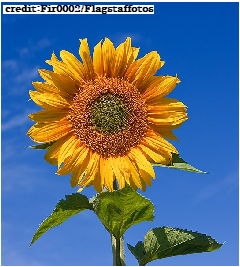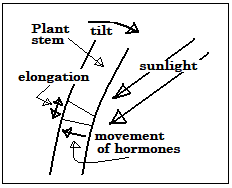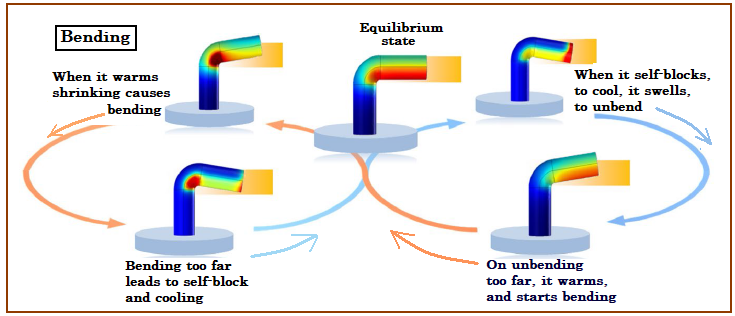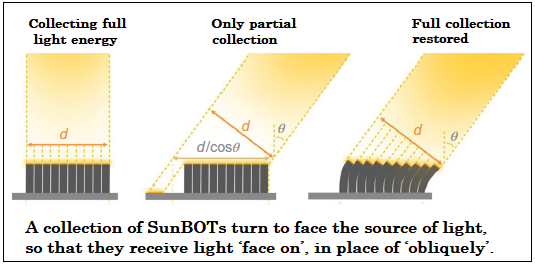“Ah, sunflower.. Who countest the steps of the sun
Seeking after that sweet golden clime.”
--William Blake..
S.Ananthanarayanan
Blake’s poem is about the legend of Clytie, a young girl who pines for Hyperion, the sun God, but was turned into a flower that always faces the sun. And the sunflower, or Helianthus annus, during its early, maturing phase, exhibits this behavior of turning, through the day, to keep its face towards the sun.
Xiaoshi Qian, Yusen Zhao, Yousif Alsaid, Xu Wang, Mutian Hua, Tiphaine Galy, Hamsini Gopalakrishna, Yunyun Yang, Jinsong Cui, Ning Liu, Michal Marszewski, Laurent Pilon, Hanqing Jiang?and Ximin He, from the University of California at Los Angeles and the University of Arizona at Tempe, write in the journal, Nature Nanotechnology, of artificial devices that mimic the sunflower in pointing to the direction of heat or other radiation, without any external stimulus or power supply

The common sunflower may get its name both from its resemblance to the radiating sun and from the behavior observed in its young flower stage, before maturity of the flower heads. At dawn, the flowers are seen to be pointing eastwards, to receive the rising sun, and then they keep facing the sun as the sun moves westwards. The movement reverses after sunset and at dawn the flowers are facing east again.
The sun-facing motion is seen as a circadian rhythm, or an internal cycle that repeats every 24 hours, maintained by the movement of the sun. The motion continues even when the sun is covered by clouds or the plant is shaded for a few days. And if a young plant is turned away from the sun, it reorients itself in a few days. The motion stops when the stalk is fully grown and the flower matures, and the mature flower stays fixed, usually facing east. Facing east makes for rapid warming in the morning and promotes visits by pollinators.
Many living things display this capacity to move “towards sources of certain environmental stimuli,” the authors of the paper in Nature Nanotechnology say. Cells and bacteria, for instance, migrate along a chemical gradient. In the case of plants, the behavior, which is known as phototropism, is to self-orient directly towards light sources. In many cases where movement is initiated by external stimuli, movement of organisms follows the orientation of its own anatomy, rather than the direction to the stimulus. In the case of the sunflower, the direction of movement is strictly according to the direction of the stimulus, the authors say and “…..organisms not only sense and respond to the stimuli positions, but also spontaneously and constantly adjust their movements to tightly follow the signal directions. This presents the intelligence of self-regulation via the feedback control inherent in the dynamic interactions between their bodies and the stimulus,” the authors say.
The way plants do this, the authors say, is with the help of cells that detect light, cells that are in the plant stem. When light falls on one side of the stem, plant cell hormones, called growth hormones, migrate to the opposite, shaded side. This leads to elongation of the cells on the shaded side and the stem tilts towards the illuminated side.

The authors, in their paper, present the principle of an artificial replication of the light sensitive plant, using light sensitive chain molecules that increase or shrink their dimensions according to the light that falls on them. The system based on these molecules, the sunflower-like biomimetic omnidirectional tracker, or the SunBOT, is able to “autonomously and instantaneously detect and track incident light in three-dimensional space at broad ambient temperatures with high accuracy and fast response, without auxiliary power supply or human intervention,” the authors say.
The core device is a stem-like cylindrical pillar shape made of reversibly photo-responsive materials. A number of materials may be suitable, the authors say, and they demonstrate the principle with four specific chain molecules. One is a hydrogel, a jelly-like material made of fibres that trap water, embedded with particles that absorb light and heat, and the others are chain molecules with either other molecules or special dyes as absorbers of light. The picture shows how the filaments of the light-sensitive material bend and straighten, to keep facing the direction of light.

The authors stress that the significant feature is the ‘feedback loop’, which keeps trimming the tendency of the SunBOT to turn and keeps it constantly pointed towards the source of light. . The other picture is of a collection of SunBOTs that turn to face the source of light, so that they receive the sun’s energy ‘face on’, in place of ‘obliquely’.

A number of devices that depend on harvesting of sunlight could benefit from the arrangement. The authors report that in a solar powered water vapour generation system, the SunBOT achieved a 400% improvement in the efficiency. With the current emphasis and importance of solar power, the value of the SunBOT becomes immediately apparent. The authors also emphasise the fact that the SunBOT, like the sunflower, works without an external motivator, like an electronic circuit or an electric motor. It is wholly conceivable that a panel of photovoltaic cells be kept optimally oriented by an electric motor and a set of gears. But this would need orientation in two axes, one for the daily motion of the sun and another for the seasonal. The SunBOT, in contrast, would always find the correct direction, perhaps even a direction not exactly towards the sun, if the sun is behind a cloud and the optimal direction is a little to the side.
The idea of “autonomous maximization of the input power density,” which the SunBOT embodies, could be used in a great many areas, the authors say. In Robotics, in complex tasks in changing environments, is one. The use in solar harvesting and solar cells, of course, is self-evident. There could also be ‘smart windows’, signal receivers, like antennas, which adapt orientation to seek the strongest signal, use in devices like guided surgery, in detection of emissions, enabling telescopes, or even a radar beam or a receiver of sounds, to stay pointed to a given object, the authors say.